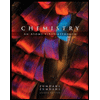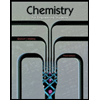
(a)
Interpretation:
Various questions on the oxidizing and reducing tendency of species based on their reduction potential are to be answered.
Concept introduction:
The species with higher reduction potential undergoes reduction at the cathode while the species with lower reduction potential undergoes oxidation at the anode. The change in Gibbs free energy is the useful amount work that can be done and negative value of
To determine: The ability of
(b)
Interpretation:
Various questions on the oxidizing and reducing tendency of species based on their reduction potential are to be answered.
Concept introduction:
The species with higher reduction potential undergoes reduction at the cathode while the species with lower reduction potential undergoes oxidation at the anode. The change in Gibbs free energy is the useful amount work that can be done and negative value of
To determine: The ability of
(c)
Interpretation:
Various questions on the oxidizing and reducing tendency of species based on their reduction potential are to be answered.
Concept introduction:
The species with higher reduction potential undergoes reduction at the cathode while the species with lower reduction potential undergoes oxidation at the anode. The change in Gibbs free energy is the useful amount work that can be done and negative value of
To determine: The ability of
Want to see the full answer?
Check out a sample textbook solution
Chapter 17 Solutions
Chemistry: An Atoms First Approach
- Using data from Table 17-1, place the following in order of increasing strength as reducing agents (all under standard conditions). Cu+,F,H,H2O,I2,Karrow_forwardRepeat the directions for Question 106 using a cell constructed of a strip of nickel immersed in a 1.0-M Ni2+ solution and a strip of silver dipping into a 1.0-M Ag+ solution. Write the balanced chemical equation for the reaction that is product-favored. Calculate the cell potential. Draw a sketch of the cell and indicate the anode, cathode, and direction of electron flow.arrow_forwardA galvanic cell is based on the following half-reactions: In this cell, the copper compartment contains a copper electrode and [Cu2+] = 1.00 M, and the vanadium compartment contains a vanadium electrode and V2+ at an unknown concentration. The compartment containing the vanadium (1.00 L of solution) was titrated with 0.0800 M H2EDTA2, resulting in the reaction H2EDTA2(aq)+V2+(aq)VEDTA2(aq)+2H+(aq)K=? The potential of the cell was monitored to determine the stoichiometric point for the process, which occurred at a volume of 500.0 mL H2EDTA2 solution added. At the stoichiometric point, was observed to be 1 .98 V. The solution was buffered at a pH of 10.00. a. Calculate before the titration was carried out. b. Calculate the value of the equilibrium constant, K, for the titration reaction. c. Calculate at the halfway point in the titration.arrow_forward
- An aqueous solution of an unknown salt of vanadium is electrolyzed by a current of 2.50 amps for 1.90 hours. The electroplating is carried out with an efficiency of 95.0%, resulting in a deposit of 2.850 g of vanadium. a How many faradays are required to deposit the vanadium? b What is the charge on the vanadium ions (based on your calculations)?arrow_forwardUsing values from the table of standard reduction potentials, calculate the cell potentials of the following cells. (a) Fe(s)|Fe2+(aq)Hg2+(aq)|Hg(l) (b) Pt(s)|Fe2+(aq),Fe3+(aq)MnO4(aq),H+(aq),Mn2+(aq)|Pt(s) (c) Pt(s)|Cl2(g)|Cl-(aq)Au+(aq)|Au(s)arrow_forwardGalvanic cells harness spontaneous oxidationreduction reactions to produce work by producing a current. They do so by controlling the flow of electrons from the species oxidized to the species reduced. How is a galvanic cell designed? What is in the cathode compartment? The anode compartment? What purpose do electrodes serve? Which way do electrons always flow in the wire connecting the two electrodes in a galvanic cell? Why is it necessary to use a salt bridge or a porous disk in a galvanic cell? Which way do cations flow in the salt bridge? Which way do the anions flow? What is a cell potential and what is a volt?arrow_forward
- For the following half-reaction, = 2.07 V: A1F63(aq)+3eAl(s)+6F(aq) Using data from Table 17-1, calculate the equilibrium constant at 25C for the reaction A13+(aq)+6F(aq)A1F63(aq)K=?arrow_forwardFor the cell: Cr|Cr3+Co2+|Co E° is 0.46 V. The same cell was prepared in the laboratory at standard conditions. The voltage obtained was 0.40 V. A possible explanation for the difference is (a) the surface area of the chromium electrode was smaller than the cobalt electrode. (b) the mass of the chromium electrode was larger than the mass of the cobalt electrode. (c) the concentration of Cr(NO3)2 solution used was less than 1.0 M. (d) the concentration of Cr(NO3)2 solution used was less than 1.0 M. (e) the volume of Cr(NO3)2 solution used was larger than the volume of Cr(NO3)2 solution used.arrow_forwardUse Table 17.1 to answer the following questions. Use LT (for is less than), GT (for is greater than), EQ (for is equal to), or MI (for more information required). (a) For the half reaction 12Br2(l)+eBr(aq)Ered1.077 v. (b) For the reaction 2Br(aq)+Co2+(aq)Br2(l)+Co(s)E0. (c) If the half reaction Co2+(aq)+2eCo(s) is designated as the new standard where Ered is 0.00, then Ered for 2H+(aq)+2eH2(g) is 0. (d) For the reaction 2Cr3+(aq)+3Co(s)2Cr(s)+3Co2+(aq) the number of electrons exchanged is6. (e) For the reaction described in (d), the number of coulombs that passes through the cell is9.648104 .arrow_forward
 ChemistryChemistryISBN:9781305957404Author:Steven S. Zumdahl, Susan A. Zumdahl, Donald J. DeCostePublisher:Cengage Learning
ChemistryChemistryISBN:9781305957404Author:Steven S. Zumdahl, Susan A. Zumdahl, Donald J. DeCostePublisher:Cengage Learning Chemistry: An Atoms First ApproachChemistryISBN:9781305079243Author:Steven S. Zumdahl, Susan A. ZumdahlPublisher:Cengage Learning
Chemistry: An Atoms First ApproachChemistryISBN:9781305079243Author:Steven S. Zumdahl, Susan A. ZumdahlPublisher:Cengage Learning
 Chemistry: Principles and ReactionsChemistryISBN:9781305079373Author:William L. Masterton, Cecile N. HurleyPublisher:Cengage Learning
Chemistry: Principles and ReactionsChemistryISBN:9781305079373Author:William L. Masterton, Cecile N. HurleyPublisher:Cengage Learning Chemistry for Engineering StudentsChemistryISBN:9781337398909Author:Lawrence S. Brown, Tom HolmePublisher:Cengage Learning
Chemistry for Engineering StudentsChemistryISBN:9781337398909Author:Lawrence S. Brown, Tom HolmePublisher:Cengage Learning Chemistry for Engineering StudentsChemistryISBN:9781285199023Author:Lawrence S. Brown, Tom HolmePublisher:Cengage Learning
Chemistry for Engineering StudentsChemistryISBN:9781285199023Author:Lawrence S. Brown, Tom HolmePublisher:Cengage Learning





